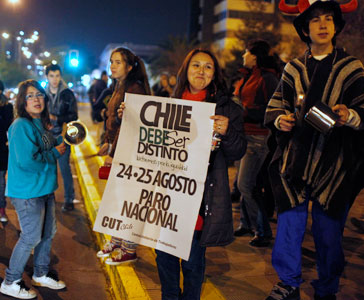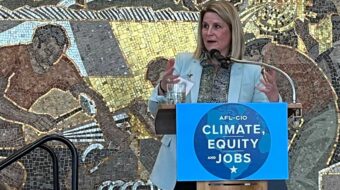
On its second day, August 25, a national strike called by the Workers’ United Center of Chile (CUT), massed 400, 000 people in the capital city of Santiago and 200,000 elsewhere. The labor federation was demanding a new labor code and protesting against privatization and cuts in pensions, education and health care. Above all, it was about basic change. Banners said: “A new political Constitution,” “I fight for my children,” and “Chile must be different.” CUT president Arturo Martinez spoke of “a new economic model and a new constitution.” “Society is expressing itself to advance toward equality in every sense,” he told an interviewer.
President Sebastián Piñera labeled the work stoppage as “illegal and unjustified.” The police arrested 1394 marchers, wounded dozens, and killed a 16-year-old boy.
This year popular mobilizations are confronting the market-driven system serving Chile’s elite, a legacy of the Pinochet dictatorship. They are on a scale last seen during the era of President Salvador Allende, who was overthrown in a brutal, U.S. assisted coup in 1973.
Copper miners have struck, indigenous activists are taking over land and fasting, protests are surging against dams blocking off Patagonian rivers, gay and lesbian people are demonstrating, earthquake victims are protesting homelessness, poor people in Magellanes are fighting against high natural gas prices, while others in Calama want the world’s largest copper mine, nearby, to benefit them.
These actions are backdrop for an emboldened student movement. For almost four months students have conducted larger and larger demonstrations and marches, even hunger strikes. The Piñera government cut interest rates on student loans, promised increased education spending, and agreed to constitutional amendments guaranteeing quality education, and protest continued. The students’ campaign culminated on August 21 in a gathering in Santiago’s O’Higgins Park. One million young people heard performances by 15 bands and listened to public speakers.
The 23-year-old president of the Student Federation of the University of Chile (FECH), Camila Vallejo, told them “this neoliberal model is not working for us. Its ultimate purpose is the profit and business of a few. We believe it’s necessary to advance toward a system more egalitarian and inclusive. [We want] a free country, a just country, more democratic, more egalitarian. And for that we need a quality education for all.”
Some, remembering Dolores Ibárruri, Spanish Civil war hero, refer to Communist Youth member Vallejo as “La Pasionaria of 2011.” She’s under police protection because of death threats.
Building on mobilizations in 1997-97 and in 2006, “The Chilean Student movement has been the most important in Latin America in the last 50 years,” asserts one Punto Final writer. Observers say university students’ awareness of their overall middle class origins has impelled leaders to reach out to organized workers to strengthen a movement for basic societal change. Students provided the impetus for the CUT national strike and filled the ranks of demonstrators then.
They call for opening up education to those unable to pay, for renationalization of copper mines and tax reforms to cover costs. They protest municipalities now being given authority over educational standards, no longer the national government, and demand a plebiscite to define the purpose of education in Chile. They point out that the 1980 constitution, product of the Pinochet dictatorship, contains provisions like the “qualified quorum” and “binomial electoral system” that impede change toward real democracy. They join unionists and social movements in calling for a constituent assembly.
Now over the last 30 years, 60 percent of basic and secondary schools and most universities in Chile have been privatized. Even public universities require heavy fees, with indebtedness affecting 70 percent of all university students. Some 65 percent of university students from poor families drop out. Monthly university costs range from $250 to $860. Chileans’ average monthly salary is $1150.
The state dedicates only 4.4 percent of Chile’s GDP to education, but UNESCO recommends 7 percent or more. Students and families pay 75 percent of Chilean educational costs. Chile now ranks within the world’s 15 most unequal countries.
Because of the student movement, “Chilean society has woken up after being half asleep for two decades,” says analyst Victor de la Fuente. “The student movement struck out at the very bases of the neoliberal system, demanding a role for the state and asking that education not be regarded as a piece of merchandise. They require an end to an educational system based on profit, left over from the military dictatorship.”
In mid August, Communist Party President and Chamber of Deputies delegate Guillermo Teillier told foreign correspondents that “the next government of Chile can’t put aside demands in the street today.” He predicted governments formed by rightwing or center-left coalitions, products of the binomial electoral system, will disappear. Teillier lauded “a new generation no longer afraid of what the dictatorship will do if they are out in the streets.”
Photo: Sign that reads in Spanish “Chile must be different, national strike on August 24 and 25,” at protest in Plaza Nunoa, Santiago, Aug. 23. (Roberto Candia/AP)

MOST POPULAR TODAY

After months of denial, U.S. admits to running Ukraine biolabs


“Trail of Tears Walk” commemorates Native Americans’ forced removal

Hold the communism, please: SFMOMA’s Diego Rivera exhibit downplays artist’s radical politics

‘Warning! This product supports genocide’: Michigan group aims to educate consumers






Comments